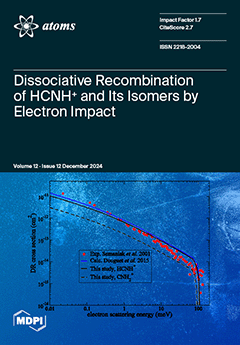Protonated hydrogen cyanide, HCNH
+, is one of the most important molecules of interest in the astrophysical and astrochemical fields. This molecule not only plays the role of a reaction intermediary in various types of interstellar reactions but was also identified in
[...] Read more.
Protonated hydrogen cyanide, HCNH
+, is one of the most important molecules of interest in the astrophysical and astrochemical fields. This molecule not only plays the role of a reaction intermediary in various types of interstellar reactions but was also identified in Titan’s upper atmosphere. The cross sections for the dissociative recombination (DR) and vibrational (de-)excitation (VE and VDE) of HCNH
+ and its
isomer are computed using a theoretical approach based on a combination of the normal mode approximation for the vibrational states of the target ions and the UK R-matrix code to evaluate electron-ion scattering matrices for fixed geometries of ions. The theoretical convoluted DR cross section for HCNH
+ agrees well with the experimental data and a previous study. It was also found that the DR of the
isomer is important, which suggests that this ion might be present in DR experiments of HCNH
+. Moreover, the ab initio calculations performed on the H
2CN
+ isomer predict that this ion is a transition state. This result was confirmed by the study of the reaction path of the HCNH
+ isomerization that was carried out by evaluating the intrinsic reaction coordinate (IRC). Finally, thermally averaged rate coefficients derived from the cross sections are provided for temperatures in the 10–10,000 K range. A comprehensive set of calculations is performed to assess the uncertainty of the obtained data. These results should help in modeling non-LTE spectra of HCNH
+, taking into account the role of its most stable isomer, in various astrophysical environments.
Full article





